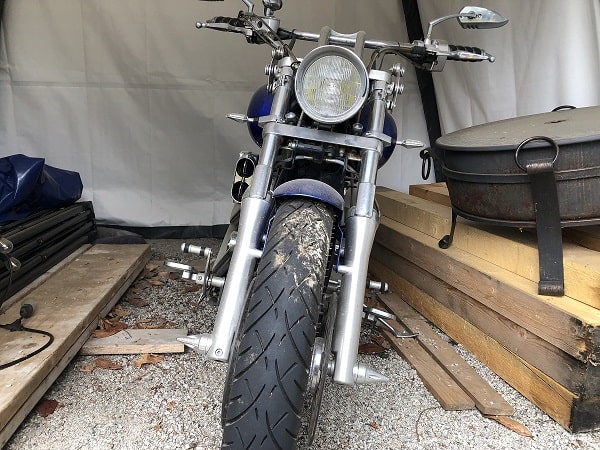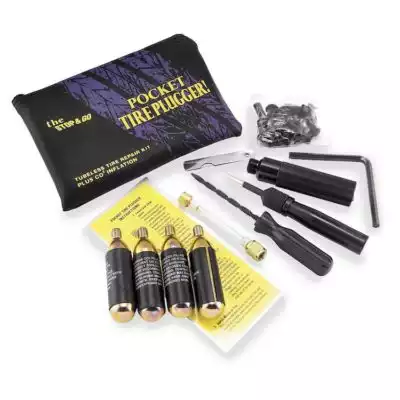Few things are more annoying than a ride out being forced to a halt because of some issue, and a puncture is one of the most irritating.
Unless you are prepared with a repair kit and quite handy with basic tools, it can mean the end of your ride and a long wait for a tow truck.
There are many questions about the safety and process of plugging your tire; we’ve gathered all the facts in one place, so you know what’s what.
Can you plug a motorcycle tire?
Yes, you can absolutely plug a motorcycle tire, which will serve as a means to keep you on your way.
However, you must note the following points:
- Plugging a tire with a repair kit is a temporary measure until you replace your tire. Until then, you should ride cautiously, checking your tire regularly.
- Only tubeless tires can be plugged. Tires with inner tubes require the tube to be removed, and the tube itself can be patched.
- Many tire manufacturers prefer you to replace your tire immediately instead of using a repair kit to plug your puncture.
Let’s dig into things a little deeper, so you are fully in the know when plugging a motorcycle tire.
Is plugging your tire safe?

There really isn’t a simple answer as to whether using a repair kit to plug your tire is safe or not, as the topic is quite divisive.
The overall consensus tends to be this: Yes, plugging your tire is safe, but only for a limited distance and to be used as a temporary measure.
There are many variables associated with plugging your tire to determine whether it is safe or not.
- How well have you done the repair?
- How much tread is left on the tire?
- The position of the plug?
- Are you riding on the straight, or are there lots of twisties to get where you are going?
Among these critical variables, the damage’s size and shape also impact the integrity of the repair.
What do tire manufacturers say?
Motorcyclist magazine contacted several leading tire manufacturers, and the overriding position was “Call a tow truck”. The reasoning being there are too many variables to know if the plug will sustain a journey of any distance without putting the rider at risk.
Of course, you could argue it is more beneficial for tire manufacturers if riders replace their tires every time they get a puncture instead of repairing them!
It is worth noting that even manufacturers who produce tire repair kits market them as emergency and temporary fixes.
Interestingly when Motorcyclist spoke to other brands, specifically Avon, Bridgestone, Dunlop, and Metzeler, they got the following response:
Yes, punctures can be plugged in an emergency situation, and a repair that both fills the wound (plug) and seals the damage (patch) that is installed by a professional can even be considered permanent if specific criteria are met.”
Overall thoughts on the safety of a plug
Even our most reputable manufacturers disagree, which leads me to believe you should always err on the side of caution; after all, we all know the risks of riding a motorcycle.
A plug repair kit used by the average rider on the side of the road to fix a puncture should be treated as an emergency, temporary means to get you home or to your destination. At which point, you should replace your tire at your earliest convenience.
The only exception would be if you take your tire to a garage and have a professional install a plug and repair the damage (from inside the tire, too, with a patch). In this case, it may be acceptable to continue to ride on the tire as usual.
However, this risk is the rider’s own to make, and if you are taking the bike into the shop anyway, I think it would be better to eliminate all risk and swap the tire out.
How to plug a tire
First of all, you need to get the right equipment together to be able to plug a tire in the event of a puncture.
There are several tire repair kits on the market. Some are minimalist and others more extensive, so which you go for will depend on your available space.
The key is to be clued up on how to use the kit so you can do the repair as best you can for maximum safety.
If you are not confident doing the repair, you should not try it and call for a tow truck; the risk of not plugging the tire properly is too significant.
Types of plug kits
There are different options when it comes to kits. The most effective and popular are:
- Rubber strings found in the Oxford CO2 Tire Repair Kit
- Mushroom plugs found in the Stop & Go Tubeless Tire Plugger with CO2
- Brass tipped ropes found in the Dynaplug Tubeless Tire Repair Kit
Mushroom plugs and brass tipped ropes are good options for smaller punctures caused by things such as nails, whereas using strings as plugs will be suitable for plugging slightly bigger holes.
Key equipment you need:
- Plugs
- Insertion tool
- T-handle tire reamer
- T-handle plugger
- Rubber Cement
- Multi-tool/pliers
- Inflation method (CO2 cartridge or an air compressor)
Some kits will come with everything you need to plug your tire, whereas, with others, you will need to supplement your gear with extra bits such as CO2 cartridges or a pair of pliers.
The repair process
- Insert a plug through the eye of the plugger like threading a needle
- Remove the offending object that caused your puncture from your tire using pliers
- Using the tire reamer, insert it into the puncture and move it back and forth several times to smooth out the rubber of the tire
- If your plug is not self-vulcanizing, add rubber cement to the plug
- Push the plugger into the puncture hole until the plug is almost all the way in but sticking out slightly
- Pull the plugger out of the hole quickly without twisting; the plug should stay in the hole
- Use a knife to trim the excess
- Allow the glue to set for 15-20mins
- Use the air compressor/CO2 cartridges to inflate your tire
- Check for leaks
Monitor your fix
You should ride especially carefully on your tire, slower than usual and more steady. After several miles, stop and check the tire for a slow leak and check the plug has remained in place.
Be sure to check again at 50 miles and then around 100 miles, at which point you should consider replacing the tire.
If you decide to keep riding on the plugged tire, regularly check it before and after every ride for any movement, wear around the plug or anything that doesn’t look right. If the tire starts to lose air, you should replace the tire immediately.
FAQ
When should you change your tire if you have repaired it after a puncture?
You should treat your repair as a temporary measure and replace your tire as soon as possible.
If your tire has been repaired by a professional who has plugged and patched the damaged area, then you may decide that you can ride on the tire for a normal life cycle.
How many miles can a plugged tire go for?
There is no straight answer as to how many miles a plugged tire is capable of.
A quick google search will come up with stories of very few miles to a couple of thousand.
There are too many variables to answer this clearly.
Final Thoughts
Plugging a tire is a muddy subject, but hopefully, we have shone a light on the topic so you can decide whether plugging your tire is a good idea.
We think that using a repair kit in an emergency as a temporary measure providing you are confident in the process and are prepared to take it easy as you continue your ride is an okay, safe thing to do. Still, we highly recommend you change your tire as soon as possible
Also see: Can you put a tube in a tubeless tire?
